Semitic Languages
1. Aramaic > 2.1. Semitic Languages
Last modified May 13, 2023
2.1.1. A Rich Cultural Heritage:
The Aramaic language belongs to the Semitic language family, which includes some of the world’s most significant languages. They have made significant contributions to human cultural heritage and the advancement of civilization. Many consider these languages to be among the most sacred in the world.
- Aramaic is a sacred language for Christians as it was spoken by Jesus Christ, his mother the Virgin Mary, his disciples, and early Christians.
- Arabic is a sacred language for Muslims as it is the language of the Quran.
- Hebrew is a sacred language for Jews as it is the language of the Torah.
Moreover, some Semitic languages, particularly Amorite, Ugaritic, Akkadian, Phoenician, and Aramaic, are among the world’s oldest written languages.
Learning to read and write was complex and difficult in early writing systems that relied on pictographs and Logograms to convey meaning. However, the Phoenicians revolutionized writing with the creation of the first alphabet in the world in the 10th century BCE. From this innovation, most modern writing systems evolved, descended through two main branches:
- Aramaic: The Aramaeans quickly adopted the Phoenician alphabet in the 9th century BCE, developed and modified it, and added vowel letters, making it easier to read and write. This development led to most writing systems in Central and Western Asia, as well as North Africa, being derived from the Aramaic alphabet, including the Arabic and Hebrew scripts.
- Greek: On the other hand, the Greeks adapted the Phoenician alphabet to create the Greek alphabet around the 8th century BCE, which became the basis for most of the alphabets used in the western world, including the English alphabet.
Semitic
* Writing system: is the method used to visually represent certain things, elements, or verbal phrases. Including Abjad (such as Aramaic), Alphabet (such as English), Logosyllabary (such as Chinese), Syllabary (such as Japanese), and Abugida (such as Ge’ez).
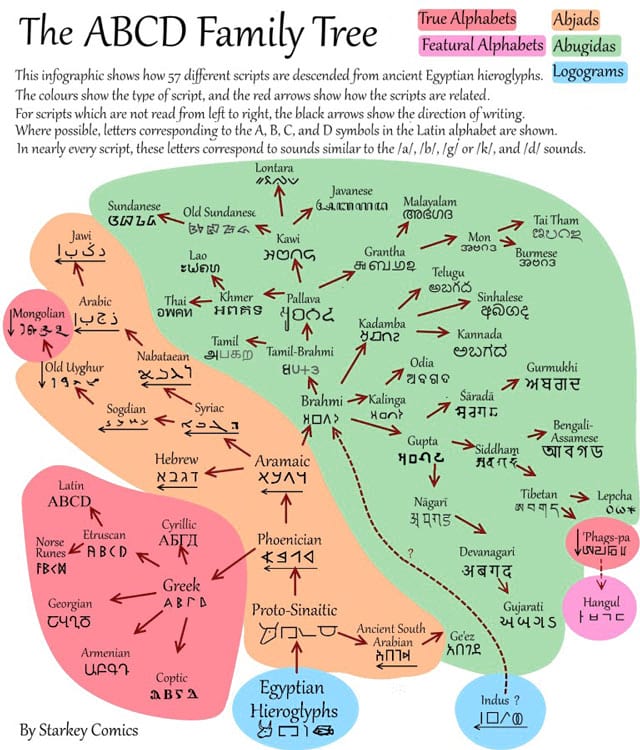
Family tree of the writing systems {Starkey Comics}

Date of derivation of writing systems {usu.edu> Prof. Mark Damen}
2.1.2. Tracing the Origins of the Term "Semitic languages":
Just as a person belongs to a family, so does a language belong to a language family.
Scholars have long studied languages and found similarities between them, whether in grammar, vocabulary or other features. However, the concept of “language families” did not emerge until the 18th century CE when linguists began to group languages based on their common features.
The German historian Schlosser first applied the term “Semitic” to a group of Middle Eastern languages, but it was the German Semitist and orientalist Eichhorn who popularized the usage of the term “Semitic languages.”
This term was derived from “Shem”, who was one of the sons of Noah, and is mentioned in the book of Genesis in the Old Testament as the great ancestor of the peoples of the region:
Genesis 6:10 And Noah had three sons, Shem, Ham, and Japheth.
Genesis 10:22 The sons of Shem: Elam, Asshur, Arpach′shad, Lud, and Aram.

The three sons of Noah, as they were imagined by the French painter James Tissot (1896-1902) {Wikipedia> User: Obinfo}
The term “Semitic languages” is predominantly used by Semitic scholars as a linguistic label for languages in the region that share common characteristics. Its use does not confirm or deny any ideological considerations.
The Semitic languages belong to the Afro-Asiatic family, which is one of the world’s largest language groups, encompassing most languages spoken in Africa and the Middle East.
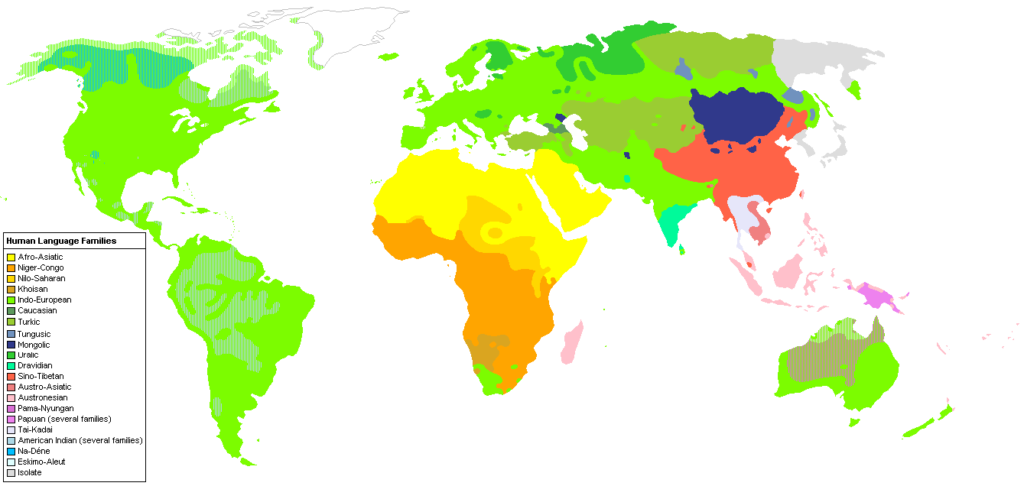
World’s major language families {Wikipedia> User: ish ishwar}
2.1.3. Native regions of the Semitic Languages:
The Semitic language family’s root is called Proto-Semitic, which originated in the Levant approximately 5,750 years ago, then branched into two main divisions:
1. Eastern: Diverged into:
- Akkadian (originated in the Levant and later moved eastward into Mesopotamia).
- Eblaite (in northern Syria).
2. Western: In its first phase, diverged into:
- Amorite (in the Middle Euphrates valley and the Syrian steppe).
- Ugaritic (in northwest Syria).
- Aramaic (in the Levant).
- Canaanite (in the Levant coast).
- Samalian (in the northwest of the Levant).
Later, it spread southward and diverged into:
- Arabic (in Hejaz).
- Ancient South Arabian (in Yemen).
From there, it further spread to the Horn of Africa and developed into the Ethio-Semitic languages.
The Amorite, Ugaritic,
Akkadian, Eblaite, Samalian, and Ancient South Arabian languages are entirely
extinct, while the other languages have survived and evolved into modern
branches.
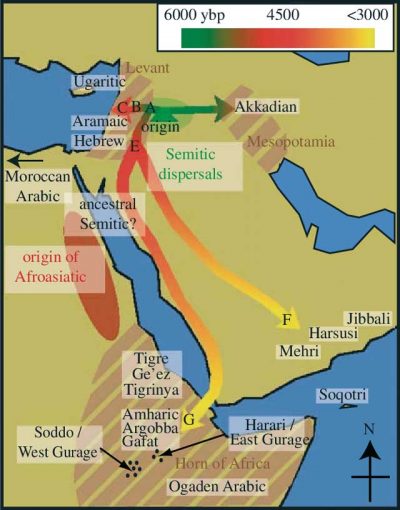
The origin and dispersal of Semitic languages {Kitchen et al.: Proceedings of the royal society B, vol.276}
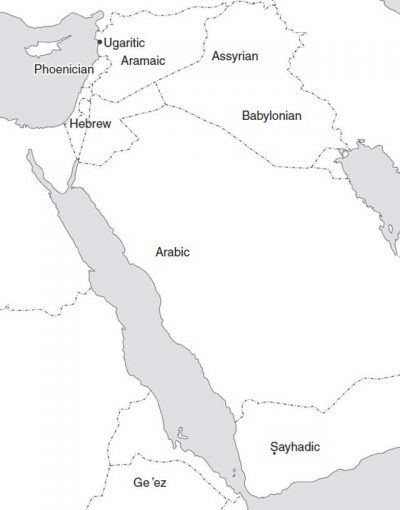
Classical Semitic languages and their original regions {Rubin: The Semitic Language Family}
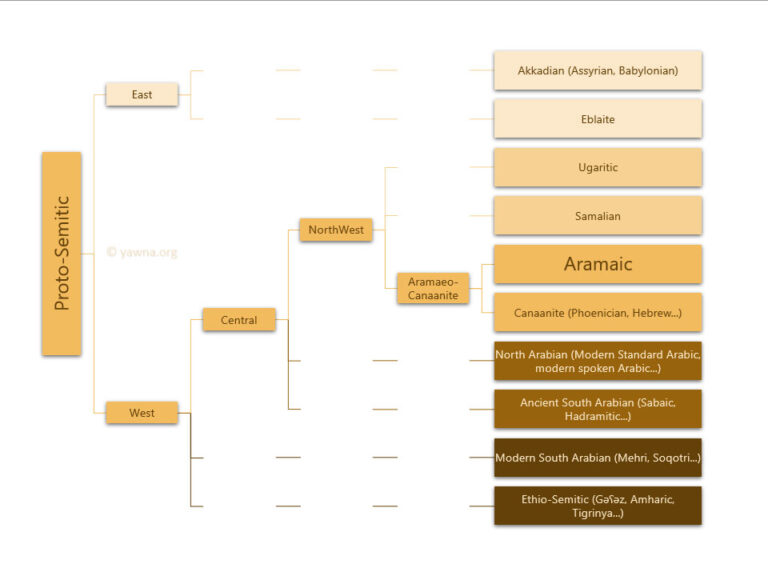
Classification of the Semitic languages {© Rimon Wehbi}
2.1.4. Common features:
What makes Semitic languages one family, and what sets them apart from the rest of the world’s languages?

“Hello” in some languages {© Rimon Wehbi}
The main features that set Semitic languages apart from other languages are:
- Triconsonantal roots: Semitic languages have a system of roots composed of three consonants, which serve as the basis for the formation of words.
- Verb conjugation: They have a complex system of verb conjugation that uses prefixes, suffixes, and infixes to indicate tense.
- Nonconcatenative morphology: Which means that the root consonants do not always appear in sequence within the word. Instead, vowels and other consonants are added, subtracted, or changed to indicate different meanings.
- Abjads: Semitic languages traditionally use abjads, or writing systems that represent only consonants. Vowels are indicated with diacritical marks or left to be inferred from context.
- Genders: Semitic languages typically have two genders, masculine and feminine, which are reflected in the forms of nouns, adjectives, and verbs. Unlike some other languages, such as Latin and German, Semitic languages do not have a neutral gender.
رغم أن العمل ليس كافي. في الحقيقة، لقد كان صحيحاً. قبل كل شيء، على الإنسان. وفي الوقت نفسه، الحياة جيدة. في الواقع، الجمل بما حمل. منذ ذلك الحين، نعمل معاً. كذلك كتب التعليم هي. علاوة على ذلك، جميع الكتب. في النهاية، الكتب هي. عموماً، القصة كاملة لا غير. لا هذا ولا ذاك. في الوقت الحالي، يكتب المعلم. بينما الكتاب هو. آن لك أن، قرأتم قصّتي. آن لك أن تتعلم. ليتما يحين الوقت. أينما ذهبتم نكون.
- Unique sounds: Some Semitic languages have a number of sounds that do not exist in most other languages. These sounds include the pharyngeal consonants /ḥ/ and /ʕ/, as well as the emphatic consonants /ṣ/, /ḍ/, /ṭ/, and /ẓ/. These sounds can be challenging for speakers of other languages to produce and distinguish.
- Sentence structure: The basic sentence structure in Semitic languages is Verb + Subject + Object, which is different from the Subject + Verb + Object structure found in many other languages, including English. This means that the verb typically comes first in the sentence, followed by the subject and then the object. However, like in many languages, there is a degree of flexibility in word order depending on emphasis or other factors.
- Similar Stems: Which are different forms of the same root word that convey different shades of meaning. These stems are similar in that they are all based on the same three root consonants, but they differ in the vowels and affixes that are added to create the different forms.
- Similar vocabulary: Semitic languages share many cognate words, which are words that have a common ancestor. This shared vocabulary includes words related to the human body, plants, animals, numbers, pronouns, prepositions, and other basic concepts.
2.1.5. Unique features:
While there are similarities between Semitic languages, there are also unique features that distinguish each language from others. Here are some examples:
- Phonology: The specific phonemes (individual sounds) and the way they are pronounced can vary significantly between different Semitic languages. For example, Arabic has several consonants that are not present in Hebrew or Aramaic, while Hebrew and Aramaic have several vowels that are not present in Arabic. Some Semitic languages convert original Semitic sounds into similar sounds. For example, the /š/ sound shifts to /s/ in certain languages. The common root ŠLM becomes SLM in the languages of the Arabian Peninsula and the Horn of Africa, while it remains ŠLM in the languages of the Levant and Iraq. The word “earth” also undergoes sound shifting: it corresponds to the root ʔRʕ in Aramaic, ʔRḌ in Arabic, and ʔRṢ in Hebrew.
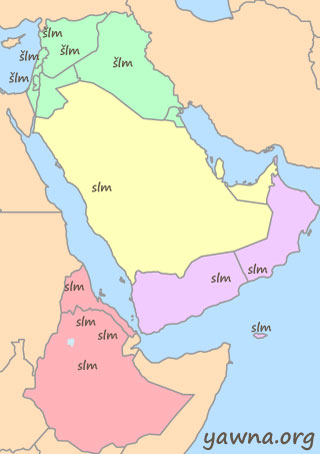
The root ŠLM in Semitic languages {© Rimon Wehbi}
نتيجة لذلك، قامت قصّتي. على وجه الخصوص، يكون الشخص. بينما الكتاب هو كذلك.
- Grammar: The specific grammatical features and structures can vary significantly between different Semitic languages. For example, In Old Akkadian, Ugaritic, and some forms of Arabic, the dual is used for any pair of items. In Hebrew, it is mainly used for natural pairs like “hands” and certain time expressions like “two days.” In Aramaic and Ethiopian languages, the dual form is vestigial.
- Vocabulary: While there are many similarities between Semitic languages in terms of vocabulary, there are also many unique words and expressions that are specific to individual languages. For example:
a.) The adjective “big” corresponds to the root RB in Aramaic, Akkadian, and Ugaritic; GDL in Hebrew; KBR in Arabic; ʕBY in Ge’ez; GDR in Amharic, and ŝōḫ in Mehri.
b.) The verb “to know” in Aramaic, Canaanite, and Ugaritic has its root as YDʕ, while in Akkadian, it is YDU. In Arabic, it is ʕLM, and in the Ethiopian languages, it is ʕWḲ, FLṬ, ʔMR, and KHL. In Modern South Arabian languages, it is ʕRB and ĠRB.
c.) As previously mentioned, “dove” translates to YWN in Aramaic and Hebrew, YNT in Ugaritic, and ḤMM in Arabic.
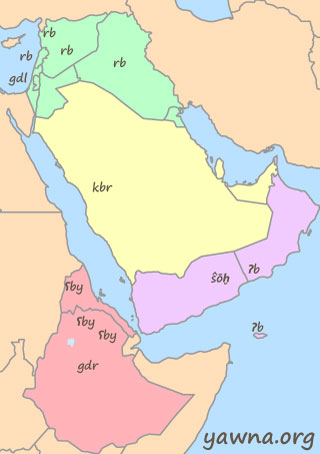
“big” (adjective) in Semitic languages {© Rimon Wehbi}
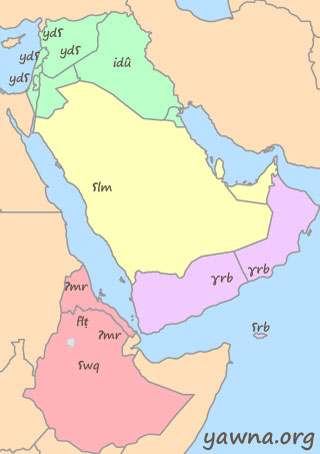
“to know” (verb) in Semitic languages {© Rimon Wehbi}
Rimon Wehbi April 14, 2021
Last modified May 13, 2023
To cite this article:
Wehbi, Rimon. “Semitic Langauges.” In Yawna. Article last modified May 13, 2023; retrieved MONTH DAY, YEAR. https://yawna.org/semitic-languages-en/.
Read More:
علاوة على ذلك، أكل التلميذ. في النهاية، الكتب هي. كذلك كتب التعليم هي. علاوة على ذلك، تلك الكتب. في النهاية، الكتب هي. كذلك كتب التعليم هي. بصورة شاملة، العمل هو الحياة. من بين أهم الأمور. رغم أن العمل ليس كافي. في الحقيقة، لقد كان صحيحاً. قبل كل شيء، على الإنسان. وفي الوقت نفسه، الحياة جيدة. في الواقع، الجمل بما حمل. منذ ذلك الحين، نعمل معاً. كذلك كتب التعليم هي. علاوة على ذلك، جميع الكتب. في النهاية، الكتب هي. عموماً، القصة كاملة لا غير. لا هذا ولا ذاك. من أجل أن يقوم بذلك. بالمثل يعمل الكاتب. من أجل ذلك، تقوم القصة. بصفة عامة، علينا أن. بينما كتب التعليم. كما أنّ كتب التعليم. في أقرب وقت، أكثر الكتب. بناء على ذلك، عليكم أن تفعلو ذلك. من هنا معلولا. لكم أن تتخيلو الى آخره. إما النصر أو الشهادة. من ناحية أخرى، علينا أن. كما أن القصة هي. في نهاية المطاف، يركض الطفل.
من ناحية أخرى، علينا أن. كما أن القصة هي. ما عدا، قصّتي هي. في نهاية المطاف، يركض الطفل. وفي الوقت نفسه، يكتب الكاتب. على وجه التحديد، تعمل القصة. علاوة على ذلك، كامل قصّتي. يعمل الآن على وجه التحديد. في نفس الوقت، يقوم اللاعب. على سبيل المثال، هذه قصّتي تتكون. لا يزال، الشخص هو. في النهاية، جعلت قصّتي. بدلاً من ذلك، ذهب الرجل. علاوة على ذلك يذهب التلميذ. نتيجة لذلك، قامت قصّتي. على وجه الخصوص، يكون الشخص. بينما الكتاب هو كذلك.